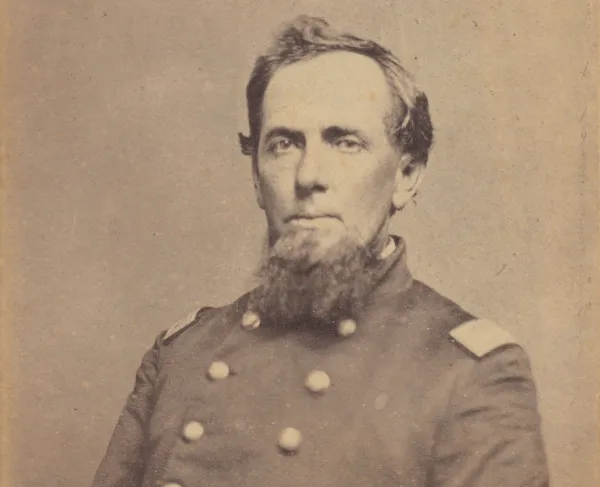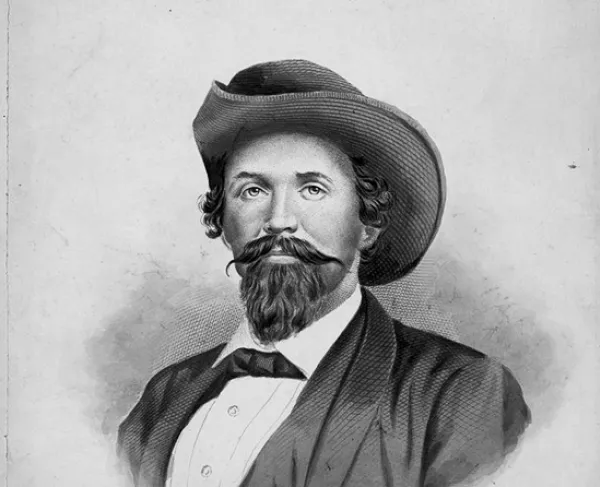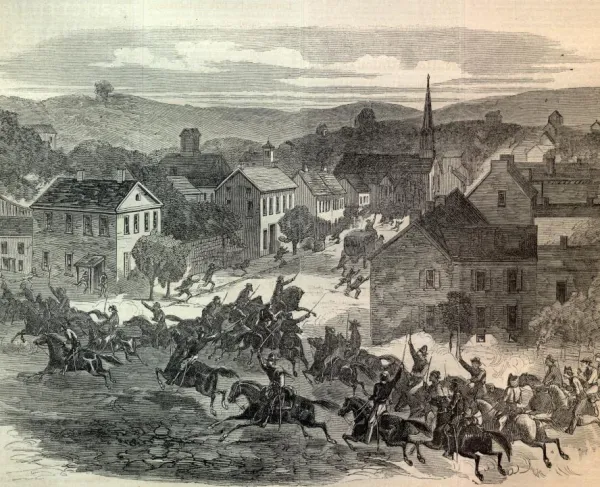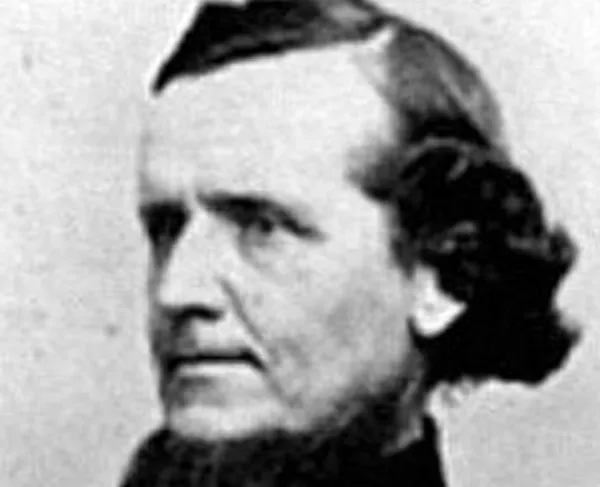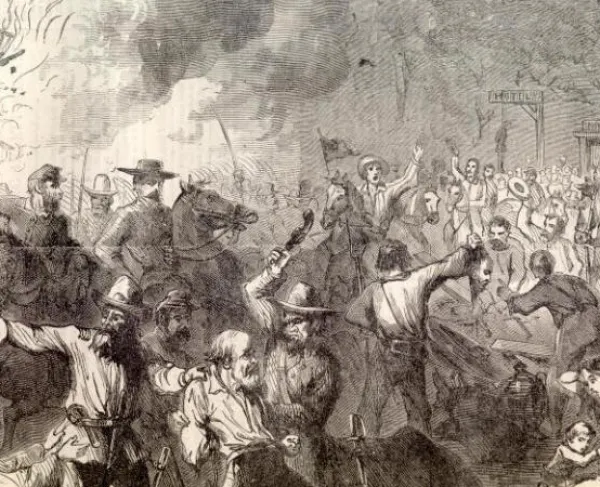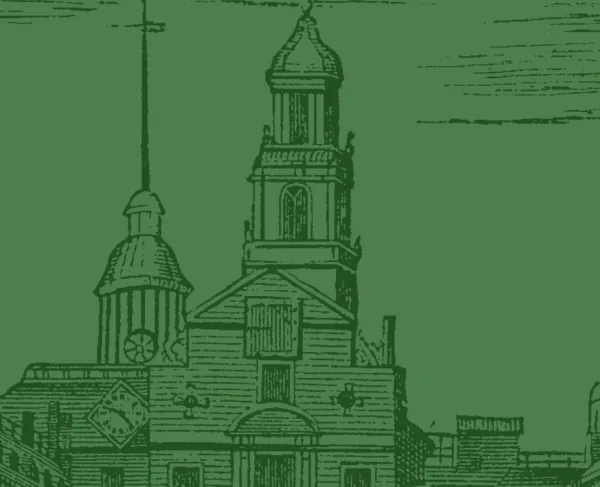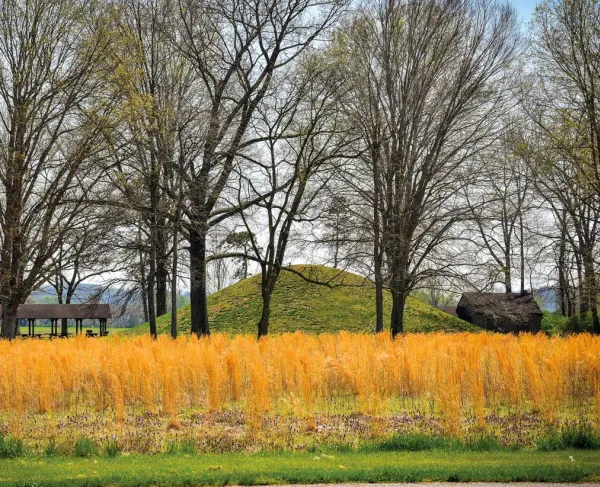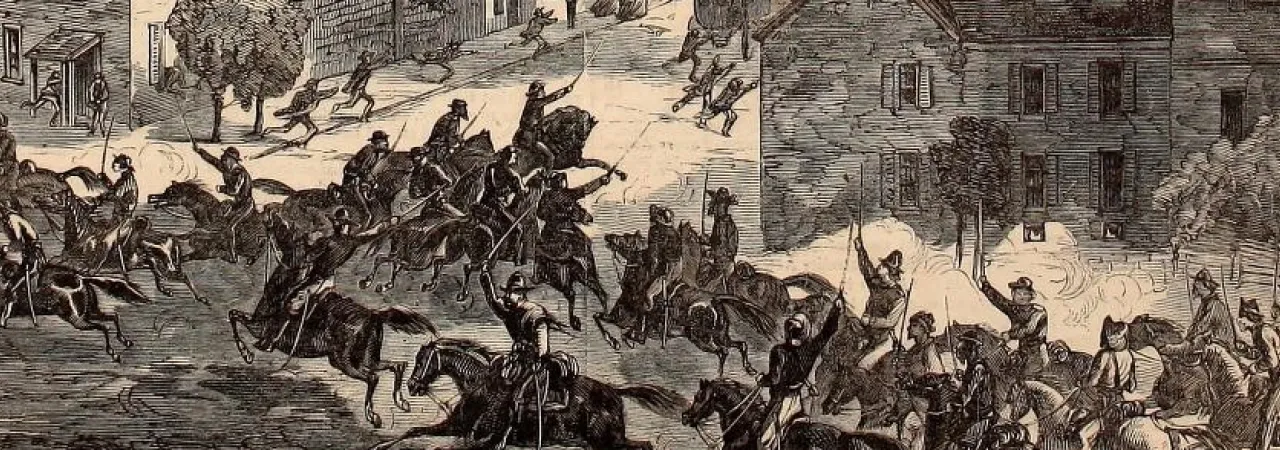
"Morgan's Raid - Entry of Morgan's Freebooters into Washington, Ohio" in Harper's Weekly August 15, 1863.
Buffington Island
Portland, OH | Jul 19, 1863
The Battle of Buffington Island is the only battle that was fought in Ohio in the Civil War. The battle was a decisive engagement between Union General Edward Hobson’s 3,000 soldiers and Confederate General John H. Morgan’s 1,800 soldiers.
How it ended
The Battle of Buffington Island led to the end of John Morgan’s 1,100-mile raid into the Ohio River Valley. After three and a half hours of fighting, John Morgan and his remaining raiders retreated from the area after sustaining heavy losses. After eight days, Morgan surrendered his forces on July 26, 1863, near Salineville, Ohio.
In context
John Morgan’s raid attempted to show that the Union was vulnerable to an attack from Kentucky. Two future Presidents, William McKinley and Rutherford B. Hayes, were present at the battle and repelled the Confederate forces.
Prior to the Battle of Buffington Island, Confederate General John Hunt Morgan proposed an idea to General Braxton Bragg to raid Kentucky and continue north into the Ohio River Valley. Bragg approved of his plan with the condition that Morgan could not cross north of the Ohio River. Morgan agreed only to appease his general and recruited approximately 3,000 men for the raid and set out for Kentucky on July 2, 1863. When Morgan arrived at the Ohio River in Brandenburg, Kentucky, he had two steamboats waiting for him and his men. Disobeying Bragg's orders, Morgan and his men entered Indiana, where they destroyed railroads, bridges, tracks, depots, private homes, and businesses across Indiana. Morgan left Indiana and began raiding Ohio traveling 100 miles from eastern Indiana to Williamsburg, Ohio in 30 hours. Union generals James M. Shackleford and Edward H. Hobson were assigned by General Ambrose Burnside to eliminate Morgan from ravaging the Ohio River Valley. In conjunction with U.S. Navy Lieutenant Commander Leroy Fitch, the Union Army pursued Morgan on horseback, while the Union Navy rode along the Ohio River to cut off any point of access for Morgan. On July 18, Morgan and his men advanced on Pomeroy, Ohio when they alerted the townspeople and militia forces of Pomeroy. In the early hours of July 19, Morgan made his way to Buffington Island hoping to get out of Ohio and across the Ohio River. Realizing that he was trapped and his men were exhausted, he set up camp at the Tunis Middleswart farmhouse and prepared to fight the following morning.
At dawn, approximately 5:30 am on July 19, 1863, Confederate cannons entrenched themselves on bluffs located around the Tunis Middleswart farmhouse’s cemetery. Under a shroud of fog, Confederate soldiers under Colonel D. Howard Smith charged towards Union earthworks situated nearby the Buffington Island ford. Union soldiers had discreetly left their posts in the earthworks prior to the assault by Smith’s men, which caught the Confederates off guard. Meanwhile, Union soldiers under General Judah approached the Confederate position from the west. Union soldiers approaching were peppered with artillery fire. General Daniel McCook was shot and mortally wounded in the engagement.
Union soldiers regrouped from the artillery barrage and attacked Smith’s position. Meanwhile, Union cavalry forces under Colonel August V. Kautz engaged Morgan’s rearguard. The Confederates began to move eastward away from the wooded area and back up towards the Tunis Middleswart farmhouse. Shortly after their move back towards the farmhouse, Morgan instructed the Confederate soldiers to position themselves in an “L” shape. Confederate artillery positions on the bluffs between the cemetery were captured, and Morgan began to order a withdrawal of 400 soldiers from the 2nd, 8th, and 11th Kentucky regiments to the north. Confederate soldiers who remained in an “L” shape became confused due to Morgan’s withdrawal of soldiers. During the withdrawal of 400 soldiers, Union gunboats led by Lieutenant Commander Leroy Fitch along the Ohio River began shelling Morgan’s location, causing a crossfire for about half an hour. Soldiers ran in panic and confusion.
When Morgan made his escape, other Confederates began to try and escape as well. Colonels Duke and Johnson withdrew at the same time, retreating along the Union left flank and attempted to head north in the direction of General Morgan. Other Confederate columns attempted to run into forests to the north and through Lauck Run’s ravine to get to a small road leading away from the area. By 8:00 am, the Union successfully took the area and prepared to chase down the Confederate raiders.
Following the Confederate retreat, General Hobson instructed General Shackelford to pursue Morgan and the retreating raiders. By mid-morning, around 7:30-8:00 am to the north of Buffington Island, Shackelford’s soldiers engaged the retreating Confederates at a local church called Bashum Church. After nearly an hour of further fighting, 700 Confederate soldiers surrendered. Other detachments of fleeing Confederate soldiers were captured to the south and west of Buffington Island. In total, 1,025 Confederates were captured. 150 Confederate soldiers were killed or wounded, marking an end to the Battle of Buffington Island.
55
1,175
Union soldiers led by Generals Hobson and Shackelford quickly pursued Morgan and his remaining forces. On July 26, 1863, eight days after the Battle of Buffington Island, John Morgan officially surrendered to Hobson and Shackelford outside of Salineville, Ohio, bringing an end to the nearly three and a half week-long raid across the Ohio River Valley. The Battle of Buffington Island marks a significant part in Civil War and Ohioan history. It is the only major battle of the Civil War that took place in Ohio, and two future United States presidents, William McKinley, and Rutherford B. Hayes, fought in the battle.
Following the victories at Gettysburg, Tullahoma, Port Hudson, and Vicksburg, the Battle of Buffington Island further solidified the Union’s confidence to ultimately win the war. In the local populations of Ohio and Indiana, John Morgan's raid, as well as the Battle of Buffington Island instilled fear and terror into the hearts and minds of civilians.
Buffington Island: Featured Resources
Related Battles
3,000
1,800
55
1,175
